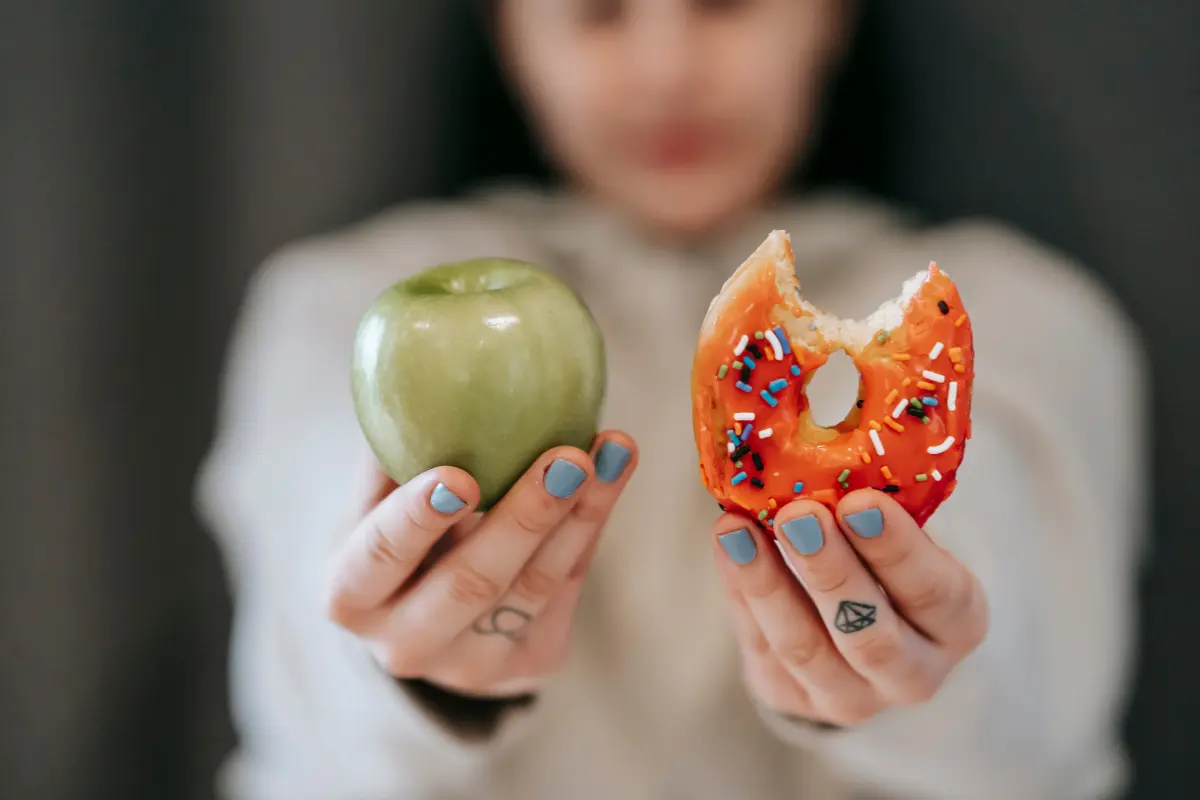
It’s one of the most frequently asked questions in health and fitness: How do I lose fat and gain muscle at the same time?
Some people phrase it differently, asking, “How do I replace fat with muscle?” or “Can I gain muscle while losing fat?” and wondering how much to eat to lose and gain muscle. We’re here today to answer these questions!
Can I Lose Fat and Gain Muscle?
Some lucky individuals can build muscle and lose fat at the same time. Beginners to a weight lifting program, athletes who have taken a substantial amount of time off or people with a lot of weight to lose are a few. We will outline and dive into each group in more detail.
Most people who “eat healthy” and “work out” regularly may struggle to build muscle and lose fat simultaneously. It doesn’t mean staying strong and dropping fat is impossible. It just means you need to focus on one goal at a time.
Advertisement
If you try to chase both goals simultaneously, chances are high you’ll end up spinning your wheels and making minimal progress toward either goal (muscle gain or fat loss).
So, how can you lose fat and gain muscle? To answer this question fully, we have to start by talking about body recomposition.
What is Body Recomposition?
“Body recomposition' occurs when there is a change to the ratio of fat to muscle in the body. When most people refer to “body recomposition,” they’re referring to dropping body fat and putting on lean muscle.
The human body isn’t one giant clump of the same tissue. Muscle and fat are two different functional ‘compartments.’
Advertisement
In other words, it is physiologically impossible to “replace” fat with muscle, or vice versa.
The Law of Thermodynamics
Let’s start by considering the first law of thermodynamics - the conservation of energy. It’s a law of energy balance.
This law states that energy can neither be created nor destroyed. Energy has to go somewhere and doesn’t just disappear.
An energy (calorie) surplus leads to storage, while an energy deficit results in energy leaving the body.
In nutrition terms, you may have heard this concept explained like this:
Advertisement
- To lose weight, you must be in a caloric deficit (consuming fewer calories than you burn).
- You must be in a caloric surplus (consuming more calories than you burn) to gain weight.
Your body needs energy to build muscle or fat cells. It releases energy when it breaks these cells down.
What Happens After You Eat?
As your body breaks down food, where do those calories go — to muscle or fat tissue? And when you burn calories (and energy leaves the body), will your body pull from your muscle or fat tissue?
This is the issue of ‘calorie partitioning,’ and it’s an essential precursor to understanding whether (and how) you could build muscle and lose fat simultaneously.
You can’t control where your calories go (fat or muscle) when you eat more or fewer of them.
If you could choose, you’d probably want all your calories to go to muscle tissue and none into body fat.
Advertisement
It would also be convenient if all calories used came from fat stores. That would make it pretty easy to lose fat and gain muscle simultaneously.
But, as physiologist and author Lyle McDonald explains, that’s not reality.
What is Calorie Partitioning
When discussing how calorie partitioning works, researchers refer to the P-ratio [1].
This represents the amount of protein gained (or lost) during over (or under) feeding.
H4: How Does Calorie Partitioning Work?
Advertisement
Most of the P-ratio is outside our direct control (primarily genetic). McDonald says we can control around 15-20% of it by eating or training [1].
Hormones are essential in determining your P-ratio:
- High testosterone levels tend to have positive partitioning effects (more muscle, less fat) [1]
- Chronically high levels of cortisol have the opposite impact (less muscle, more fat) [1]
The tricky thing is that the P-ratio describes the overall effect on your whole body. It cannot predict partitioning (in other words, when you’re in a surplus, it cannot predict the percentage of your energy that will go toward creating muscle cells vs. fat cells) [1].
Theoretically, if your body had enough stimulus (i.e. strength training), protein, and water, it could pull energy from your fat cells to build muscle tissue. That would be the closest to losing fat and gaining muscle simultaneously.
That’s theoretically possible, but it’s unlikely for most individuals. (It’s also important to acknowledge that just because something is possible, it isn’t the ideal method or strategy. More on that below.)
Advertisement
Who Can Lose Fat and Build Muscle at the Same Time?
The information above may have left you feeling a bit discouraged about your ability to gain muscle and lose fat simultaneously.
But hang on, three groups of people probably can achieve this feat!
Several factors will impact whether you can gain muscle and lose fat at the same time, including:
- Training age (i.e. how long you have been strength training)
- Current body composition
- Genetics
- Insulin sensitivity
- Hormone balance
Now, let’s dive deeper into each of the three groups.
Advertisement
How to Achieve Body Recomposition at the Gym
Beginners in the gym with a higher body fat percentage tend to drop fat while gaining (or at least maintaining) muscle.
Individuals new to strength training have a high potential for relatively rapid muscle gain. And with a higher body fat percentage, their bodies have more energy to spare and put toward muscle gain.
There is also a chance that these individuals are insulin-resistant. Put simply, this means their fat cells “don’t want” more energy [2].
When these individuals strength-train, a powerful growth stimulus is sent to their muscles. This improves their insulin sensitivity and nutrient uptake within muscle cells [2].
At the same time, their fat cells will remain insulin-resistant. So, calories are more likely to go to muscle cells [2].
Advertisement
These functions lead to simultaneous muscle gain and body fat loss in these individuals. Their transformations can be pretty impressive—it appears as if the body takes calories out of fat cells and uses them to build muscle.
It’s essential to remember, however, that this only works if both factors are present: the individual is a strength training beginner and has a higher percentage of body fat.
Someone new to strength training but relatively lean doesn’t have enough fat to “shunt” to the muscle.
And the longer you have been strength training, the slower your rate of muscle gain will be.
That is why the combination of being new to strength training and carrying a higher body fat is the “sweet spot.”
Advertisement
Can Athletes Lose Fat and Gain Muscle?
Athletes who took time off (either by choice or due to injury, etc.) and lost muscle mass and gained body fat will have a relatively easy time rebuilding that mass (thanks to ‘satellite cells’ and the ‘muscle memory’ effect) [1].
They also have training routines and schedules to help them stay consistent.
Otherwise, athletes may need to focus on one goal before turning to another. For example, a seasoned athlete may go through a calorie surplus to put on muscle and then cut weight while maintaining as much muscle as possible. More on that below!
Steroid Use and Muscle Gain
We don’t spend much time discussing this as it isn’t something we recommend, but you get the idea. Steroids essentially “override” normal physiology and make it much easier for someone to gain muscle while dropping fat.
Advertisement
How To Lose Fat and Gain Muscle Simultaneously
Since those are three smaller populations, you’re likely still wondering, “I don’t fall under those categories; can I lose fat and gain muscle simultaneously?”
The answer: maybe.
But you run the risk of “spinning your wheels” and making minimal progress in either direction. The leaner and more muscular you are, the less likely you are to lose fat and gain muscle at the same time successfully.
Put another way, the more “advanced” you are with your training and body composition, the slower “body recomposition” will likely take.
What tends to happen for many individuals is that neither their nutrition nor training program is optimized for fat loss or muscle gain. For example, they may keep their calories too low to support muscle growth but too high for fat loss.
Advertisement
This could lead to no changes happening (and how frustrating would that be?). So, what can you do about it?
Should I Build Muscle or Lose Fat First?
“Should I build muscle or lose fat first?”
For most individuals, we recommend breaking down your journey into specific phases - fat loss or muscle gain - and focusing on one at a time. This is likely to lead to quicker results.
If you’d like to learn more about how to lose fat effectively, check out this article about what it really takes to get leaner and this one about how to ensure you lose fat without losing muscle mass.
Advertisement
Focused on gaining muscle? We’ve got an article about that too.
In most cases, you’ll need to focus on dropping fat first and then reverse dieting to add more calories and slowly put on muscle. This helps you “lean out” and then stay lean as you focus your training and nutrition on muscle gain.
Monitoring body composition, measurements, and performance will help you determine whether you’re gaining muscle or fat along the way.
Not sure which one to pick first? Find your answer! From there, here are a few other things you can focus on.
Advertisement
What to Eat To Lose Fat and Gain Muscle
Wondering what to eat to lose fat and gain muscle?
Protein Needs and Muscle Gain
Protein plays a vital role in muscle maintenance. When you’re in a caloric deficit with the goal of fat loss, eating enough protein will give your body the best chance at holding onto muscle.
Protein also increases the likelihood that when your body needs energy, it won’t pull from muscle to get it. Eating adequate protein also helps muscle recovery after a tough workout [3].
How Much Protein Do I Need?
Regarding protein intake, the precise amount you need is best handled and monitored by an online nutrition coach who can prescribe an amount based on your body and training style. We also recommend talking to a doctor before making any significant changes to your diet.
Studies show that around .8-1g per pound of body weight is an excellent starting point for most people, especially for resistance training [4]. From here, you’ll need to ensure that your overall calories are in line with your goals.
Advertisement
Want to calculate your macros for free? We have you covered with our free macro calculator!
Resistance Training for Fat Loss
Resistance training stimulates muscle growth, which can help you retain more muscle while losing fat. This can help offset the potential muscle loss seen with lower-calorie diets.
Resistance training also has a high excess post-exercise oxygen consumption (EPOC) as a fat-burning bonus. This means that your metabolism may stay higher for longer after weightlifting, so you can burn more calories even after your workout.
When you gain or maintain muscle, you also increase your resting metabolic rate, or RMR, which means you burn more calories at rest.
As you can tell, losing fat and gaining muscle simultaneously is nuanced, with many moving pieces.
Advertisement
Frequently Asked Questions (FAQs) about Losing Fat and Gaining Muscle Simultaneously
How long does body recomposition actually take?
A: Body recomposition is a slower process than traditional cutting (focused fat loss) or bulking (focused muscle gain). There's no set timeline, as results depend heavily on factors like your starting body composition, training experience, genetics, consistency with nutrition and training, sleep quality, and the size of your calorie deficit. Beginners often see noticeable changes within the first 2-4 months, while more experienced individuals might see slower, more gradual progress. Patience and consistency are crucial!
Can I do cardio while trying to achieve body recomposition?
A: Yes, you absolutely can incorporate cardio for overall health benefits. However, prioritize resistance training for body recomposition, as it provides the primary stimulus for muscle growth. Use cardio strategically to support your calorie deficit and improve cardiovascular health, but avoid excessive amounts that could interfere with recovery or lead to too large a deficit, potentially hindering muscle gain. Think of resistance training as the driver and cardio as a helpful passenger.
Do I need special supplements to lose fat and gain muscle at the same time?
A: No, supplements are not required for body recomposition. Success hinges on the fundamentals: a consistent small-to-moderate calorie deficit, sufficient protein intake, progressive resistance training, adequate sleep, and managing stress.
While some supplements, like creatine monohydrate (which supports performance and muscle growth) or protein powder (which helps conveniently hit protein goals), can be beneficial, they are supplementary to a solid nutrition and training foundation. Focus on mastering the basics first. Always chat with a doctor or Registered Dietitian before adding a supplement to your routine.
Advertisement
How much protein do I really need for body recomposition?
A: Protein is critical for preserving and building muscle, especially in a calorie deficit. Aim for a higher intake than typically recommended for maintenance. A good target is generally 0.8 to 1 grams per pound body weight. Spreading this intake throughout the day can also benefit muscle protein synthesis.
Is body recomposition harder for advanced lifters?
A: Yes, generally it is. Beginners and those returning from a break have a more significant potential for simultaneous fat loss and muscle gain ("newbie gains" or muscle memory). Your body becomes more efficient as you become more trained and closer to your genetic potential. It gets harder to provide a strong enough muscle-building stimulus while also being in the calorie deficit needed for fat loss. Progress is still possible for advanced individuals, but it's typically much slower and requires more meticulous attention to detail in nutrition and training.
The Crucial Role of Patience and Consistency in Body Recomposition
While losing fat and building muscle simultaneously is incredibly appealing, it's vital to understand that body recomposition is a marathon, not a sprint. Unlike aggressive cutting or bulking phases, where changes might feel more rapid, recomp demands unwavering consistency and a healthy dose of patience.
Your body is performing a complex balancing act – fueling muscle growth while tapping into fat stores for energy, all within a slight calorie deficit. This process requires diligent adherence to your nutrition plan (hitting protein goals, maintaining the deficit) and your resistance training program (applying progressive overload) week after week.
Advertisement
Results won't appear overnight; they accumulate gradually. Trust the process, celebrate small victories like increased strength or clothes fitting better, and resist the urge to make drastic changes if you don't see your scale weight plummet immediately. True transformation takes time, and sticking steadfastly to the fundamentals is the only way to achieve sustainable, long-lasting results in body composition.
A 1:1 online nutrition coach will get to know you, your goals, and your training preferences to help you decide where to put your focus and how to work towards your body composition goals. Then, they’ll be able to track your progress with you and adjust your plan as your body changes.
References:
- McDonald, L. (2003). The Ultimate Diet 2.0. Lyle McDonald Publishing.
- McDonald, L. (2020, April 22). Insulin Resistance and Fat Loss. Retrieved July 19, 2020, from https://bodyrecomposition.com/fat-loss/insulin-resistance-fat-loss
- Helms, E., PhD, Valdez, A., MS, & Morgan, A., BS. (n.d.). The Muscle & Strength Pyramid: Nutrition (2nd ed.). Retrieved July 10, 2020.
- Leidy, H. J., Clifton, P. M., Astrup, A., Wycherley, T. P., Westerterp-Plantenga, M. S., Luscombe-Marsh, N. D., Woods, S. C., & Mattes, R. D. (2015). The role of protein in weight loss and maintenance. Am J Clin Nutr. 101(6), 1320S-1329S. doi: 10.3945/ajcn.114.084038
- Leidy, H. J., Clifton, P. M., Astrup, A., Wycherley, T. P., Westerterp-Plantenga, M. S., Luscombe-Marsh, N. D., Woods, S. C., & Mattes, R. D. (2015). The role of protein in weight loss and maintenance. Am J Clin Nutr. 101(6), 1320S-1329S. doi: 10.3945/ajcn.114.084038
- Helms, E. R., Zinn, C., Rowlands, D. S., & Brown, S. R. (2014). A systematic review of dietary protein during caloric restriction in resistance trained lean athletes: a case for higher intakes. International Journal of Sport Nutrition and Exercise Metabolism,24(2), 127-138. doi:10.1123/ijsnem.2013-0054
Schedule a Free Intro Call
Working Against Gravity has led the macro tracking and health space for over a decade. Our team doesn’t just understand the science of nutrition—we’ve spent years mastering the art of tailoring it to fit your life. That means no cookie-cutter plans, just real strategies that have worked for over 30,000 people.
Schedule a free call with our team to learn how working with a 1-on-1 WAG coach will help you reach your goals.



